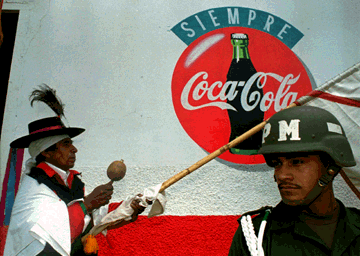Mar
2
Folk Culture & Modernity
Posted by: Brian | March 2, 2009 | Comments Off on Folk Culture & Modernity
Both articles this week were full of ideas that really resonated with me. However, I found myself skimming over parts of both articles in search of what was really essential to the arguments being made.
In Mexican Murals in Times of Crisis, by Bruce Campbell, Murals provide a perfect example of what popular culture is in Latin America and shows how all the issues we’ve discussed to date regarding popular culture work together, culminating in the creation of a work of art. Murals in Mexico have gone through many shifts throughout time, responding to the shifts occurring in Mexican politics. This idea reinforces the rejection of the likening of popular culture to a coral reef in that it proves popular culture is forever changing and adapting to current events occurring in the economic, political or social realms of society. The ability for popular cultural forms to adapt to changing environments keeps it relevant.
Murals in Mexico also blend together notions of “high” culture and low or popular culture. Campbell mentions that the mural combines elements of “European high modernism (futurism, experssionism, cubism) with the ideological and cultural components of a Mexico in the process of institutional consolidation after a protracted and devastating revolutionary war.” (p. 14) The use of European high modernism would presumably be categorized as high culture. However, considering the context in which these murals were painted, the political, economic and social turmoil that Mexico was experiencing during this times would most likely appear as topics for these murals. This is a characteristic of popular culture.
There is another way in which murals blend together the ideas of high culture and popular culture. The mural form itself is associated with a certain amount of prestige, as it is considered an art form, thereby categorizing it as high culture. However, the topics and issues depicted in murals usually speak for the people marginalized and oppressed in society, thereby placing murals as a popular culture art form. As well, murals are normally painted in public spheres, accesisble by almost all, again categorizing murals as popular culture. A clash occurs between these two opposing representations of mural art.
Campbell mentions that “mural art continues to be accorded great national prestige as a public cultural form” (p. 29). However, at the same time mural art “is destroyed…[it] falls victim to censorious government officials uncomfortable with the content of images.” I find similarities between mural art and Native art in Canada. Mural art is used as a symbol of national identity in Mexico, as Native art is used as a symbol of Canadian National identity, particularly on the West Cost. However, mural art is not regarded well by government officials, while in Canada, Native art and the Native people are not regarded well by not only government officials, but society in general.
I found The Spirit Queen’s Court, by Michael Taussig, a difficult, but extremely interesting article to read. I had a bit of difficulty figuring out how the article ties into the topic for this week, folk culture and modernity.
I believe that the interaction between folk culture and modernity is seen with the spiritual encounters and portals used to house these spiritual encounters. The portals all tend to have 4 important figures: the spirit queen, el negro primero, el indio, and the Liberator. I believe these characters portray the interaction between folk culture and modernity. These figures have been given certain meanings by the people. Presumably, the spirit queen and perhaps the negro primero could symbolize folk culture while the Liberator symbolizes modernity. El indio is a bit more confusing. Indigenous-ness is often associated with folk culture, and therefore we might assume el indio to represent it. However, the article mentions that this country has practically no indigenous people, and the depiction of el indio is actually of a US Plains indian. Therefore, el indio is not really a representation of folk culture as it does not originate from the country.
In any case, these figures have been given certain meanings, important in bringing about these spiritual encounters. These rituals, seances, and spiritual awakenings have continued to be performed, despite colonial rule and the imposition of Christianity in Latin America.
